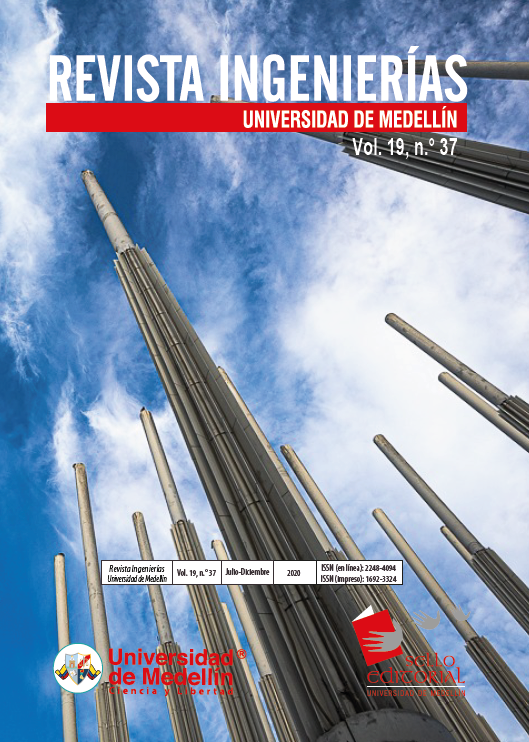Corrosion State in Metal Pipes and Fittings Exposed to Air Based on Fuzzy Sets
DOI:
https://doi.org/10.22395/rium.v19n37a12Keywords:
Corrosion, visual inspection, diffuse logic, coating, pipelinesAbstract
Metallic materials used in drinking water distribution systems show corrosion damage, which makes it necessary to develop simple and accessible methods that allow preventive and / or corrective measures to be carried out quickly. The work that is described in this paper intended to build a fuzzy logic model based on data obtained from visual inspections of the cladding, and the visible deterioration appearances degree (aging) of the elements. The methodological design used was quantitative research, also known as a mathematical approach, distinguished by the interpretation of data, statistics, numbers, and tables, among others. The data and records of various pressure reducing stations (ERPs) in zones 1 and 4 of aqueduct and sewer in Bogotá were analyzed. Fuzzy Logic ToolboxTM MATLAB software complementing was used, based on the selection of two parameters (protection, and coating and aging). Each one was assigned quality conditions that operated as the program input data. By applying the model, a three-dimensional surface was obtained with the values of the corrosion states, according to the quality of the coating and the aging dimension. Four zones were identified, which represent the corrosion states of the evaluated elements: optimal, imperceptible, light, and severe, with no transition interval. The results show that this methodology provides a reliable evaluation of the state of corrosion of the evaluated metal structures. It is concluded that the implementation of the fuzzy inference system provides a simple application tool, which can be adjusted with information collected in routine preventive or corrective maintenance work, and in activities that relate other variables to corrosion.
Downloads
References
[1] N. Asrar, B. Mackay, Ø. Birketveit, M. Stipanicev, J. Jackson, A. Jenkins, D. Melot., J. Sheie, J. Vittonato. “La corrosión: La lucha más extensaâ€. Oilfield Review, vol. 28, n.° 2, pp. 36-51, 2016.
[2] R. Galván-MartÃnez, D. Cabrera-de la Cruz, A. Contreras, R. Orozco-Cruz. “A novel experimental arrangement for corrosion study of X60 pipeline steel weldments at turbulent flow conditionsâ€. Corrosion Engineering, Science and Technology, vol 51, n.° 6, pp. 80-91, 2016. DOI: 10.1080/1478422X.2015.1124598.
[3] W. Smith, “Corrosiónâ€, en Fundamentos de la ciencia e ingenierÃa de materiales, Madrid: McGraw-Hill Interamericana, 1998, pp. 718-777.
[4] American Water Works Association AWWA, C210-15 Liquid-Epoxy Coatings and Linings for Steel Water Pipe and Fittings. Denver: American Water Works Association, 2015.
[5] J. Rebollo, “Técnicas de protecciones de tuberÃas y accesoriosâ€, en Montaje de redes de distribución de agua, Bogotá: Ediciones de la U, 2014.
[6] J. Torres, E. Meraz y L. Veleva, “Evaluación de un sistema de protección catódica de un gasoducto enterradoâ€, Revista Latinoamericana de Metalurgia y Materiales, vol. 37, n.° 1, pp.19-26, 2017.
[7] V. Tzatchkov, V. Alcocer, V. Bourguett y F. ArreguÃn. “Rehabilitación de tuberÃas de agua potableâ€, en: Avances en la hidráulica de redes de distribución de agua potable, México D.F.: Instituto Mexicano de TecnologÃa del Agua, 2014, pp. 363-376.
[8] F. Pancorbo, Corrosión, degradación y envejecimiento de los materiales empleados en la edificación, Bogotá: Alfaomega, 2013.
[9] G. Macioski, D. de Souza, A. Capraro y H. Medeiros. “Analysis of steer bars corrosion as a function of the environment Phâ€. Revista ALCONPAT, vol. 6, n.° 3, pp. 223-234, 2016. DOI:
21041/rav6i3.153.
[10] M. Fontana, “Corrosion Principlesâ€, en Corrosion Engineering, Singapur: McGraw-Hill, 1987, pp. 12-38.
[11] A. Lee. “Condition Assessment Technologies for water transmission and sewage conveyance systemsâ€, en UBC Sustainability scholar program 2017 & Metro Vancouver, Vancouver, 2017. [internet]. Disponible en https://sustain.ubc.ca/sites/sustain.ubc.ca/files/Sustainability%20Scholars/2017_Sustainability_Scholars/Final_Reports/Condition%20Assessment%20Technologies%20for%20Water%20Transmission%20and%20Sewage%20Conveyance%20Systems_Lee_%202017%20SS.pdf.
[12] G. Morales, Introducción a la lógica difusa, México D.F.: Cinvestav-IPN, 2002.
[13] M. Biezma, D. Agudo y G. Barrón. “A Fuzzy Logic method: Predicting pipeline external corrosion rateâ€, International Journal of Pressure Vessels and Piping, vol. 163, pp. 56-62.
DOI: 10.1016/j.ijpvp.2018.05.001.
[14] J. Thomson y L. Wang, “Technologies for condition assessmentâ€, en Condition Assessment of Ferrous Water Transmission and Distribution Systems, Washington: EPA, 2009, pp. 14-85.
[15] MathWorks, Design and simulate fuzzy logic systems. [internet]. Disponible en https://la.mathworks.com/products/fuzzy-logic.html.
[16] R. Pérez, Procesado y optimización de Espectros Raman mediante Técnicas de Lógica Difusa: Aplicación a la identificación de Materiales Pictóricos, disertación doctoral,Departamento de TeorÃa de la Señal y Comunicaciones, Universidad Politécnica de Cataluña, Barcelona, 2005.
[17] The American Society of Mechanical Engineers, Manual for Determining the Remaining Strength of Corroded Pipelines B31G – 2012, Nueva York: ASME, 2012.
Downloads
Published
How to Cite
Issue
Section
License
The total or partial reproduction of the contents of the journal for educational, research, or academic purposes is authorized as long as the source is cited. For reproduction for other purposes, express authorization from the Sello Editorial Universidad de MedellÃn is required.

